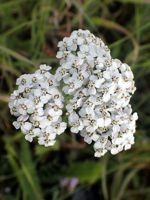Mon-Fri 9am - 5pm Mountain time
Yarrow vs Pearly Everlasting
Achillea borealis (Previously Achillea millefolium)
Anaphalis margaritacea
SOLD OUT
CUSTOM GROW
Yarrow is a herbaceous, native wildflower that is found across Canada. It features large, flat clusters of tiny white flowers. The blooms attract a variety of pollinators, making it an ideal choice for pollinator gardens. While partial shade is tolerated, the best flowering occurs in full sun. Yarrow is resistant to deer and rabbits, making it both a beautiful and practical addition to your landscape.
The entire plant is edible, but leaves and flowers are most commonly consumed. They have a strong licorice scent and a mild sweet flavor that is similar to tarragon. Yarrow leaves can also be used as a natural insect repellent.
It is important to plant Yarrow in the right place, it can spread quickly via both rhizomes and self-seeding. Deadheading the spent flowers will extend the bloom season and can help limit self-seeding.
Pearly Everlasting is a native perennial wildflower known for its clusters of white, papery flowers with yellow centres. These long-lasting blooms appear throughout summer, and the silver-grey foliage adds contrast to the landscape. Its nectar supports a variety of pollinators and serves as a host plant for painted lady caterpillars.
Pearly Everlasting is also used in dried flower arrangements. It is well-suited for pollinator gardens, naturalization, ecological restoration, and low-maintenance landscapes.
Yarrow Quick Facts
Pearly Everlasting Quick Facts
Toxicity: toxic to dogs, cats, and horses

